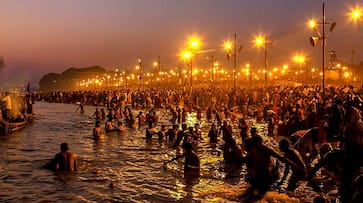Kumbh Mela Adhikari Vijay Kiran Anand told PTI Saturday that more than two crore people from different walks of life are likely to arrive here to take a dip on the occasion of Basant Panchami
All roads led to Sangam city where devotees gathered ahead of the third and the final shahi snan on Basant Panchami, falling Sunday, during which more than two crore people are expected to take a holy dip at the Kumbh Mela.
The festival of Basant Panchami heralds the arrival of spring and is dedicated to Goddess Saraswati.
Allahabad Mayor Abhilasha Gupta Nandi told PTI, "Basant Panchami is the third and last shaahi snaan of the Kumbh. By taking three dips on this day, a devotee gets the blessings of Ganga, Yamuna and the mythical Saraswati rivers. Hence, it holds tremendous significance for people."
Kumbh Mela Adhikari Vijay Kiran Anand told PTI Saturday that more than two crore people from different walks of life are likely to arrive here to take a dip on the occasion of Basant Panchami.
Akhil Bharatiya Akhara Parishad (ABAP) president Narendra Giri said there were three shahi snan or royal baths and three 'parv snaans' during the Kumbh Mela.
The Mela commenced on January 15 on Makar Sankranti, the first bathing day, and the Mahashivratri on March 4 will mark its last bathing day.
"Shahi snan is the central highlight of the Kumbh Mela and the most important part of the celebration. It is only after the completion of 'shahi snan' that people are allowed to take the holy dip, he said.
Prior to Basant Panchami, shaahi snaans were held on Makar Sankranti on January 15 and Mauni Amawasya on February 4.
Lucknow-based astrologer, Trilokinath Singh highlighted the significance of the festival.
"It marks the onset of spring (Basant), and also marks the start of preparation for Holi, the festival of colours, which occurs around 40 days later," he said.
Ashutosh Varshney of Ram Sewa Trust, who set up his camp in Sector 6 in the Mela, said, "It is said that by making a donation, of one's choice, to river Ganga on Basant Panchami, a person stands to gain knowledge."
Dhrubo Bhattacharya, a priest, said that many families, especially Bengalis, mark this day by sitting with their babies and young children, encouraging them to write their first words with their fingers, while some others study or create music together.
"In temples and educational institutions, statues of Saraswati are dressed in yellow and worshipped," he said, adding poetic and musical gatherings are also held in some communities for Goddess Saraswati.
Security personnel have been deployed at different crossings and parts of the city for Kumbh Mela. The Uttar Pradesh police too has geared up for a seamless and incident-free Kumbh, spread over 3,200 hectare land in the Sangam City.
Security arrangements would be three-tier -- in the Kumbh mela region, in Allahabad and in the adjacent districts.
"The whole region has been demarcated into nine zones and 20 sectors with the deployment of over 20,000 police personnel, 6,000 homeguards, 40 police stations, 58 outposts, 40 fire stations, 80 companies of central force and 20 companies of PAC," UP's Director General of Police (DGP) OP Singh had earlier told PTI.
Besides, there would be three police lines, one traffic police line, three women police stations and 317 police response vehicles to tackle an emergency situation with a response time of less than 10 minutes, he said, adding that mounted police would also be there.
With a view to counter any terrorist activity, Anti-Terrorist Squad (ATS) commandoes, anti-sabotage commandoes with snipers, bomb disposal units, sniffer dog squads and intelligence units have also been pressed into service, Singh said.
Last Updated Feb 10, 2019, 10:29 AM IST









![Salman Khan sets stage on fire for Anant Ambani, Radhika Merchant pre-wedding festivities [WATCH] ATG](https://static-gi.asianetnews.com/images/01hr1hh8y86gvb4kbqgnyhc0w0/whatsapp-image-2024-03-03-at-12-24-37-pm_100x60xt.jpg)
![Pregnant Deepika Padukone dances with Ranveer Singh at Anant Ambani, Radhika Merchant pre-wedding bash [WATCH] ATG](https://static-gi.asianetnews.com/images/01hr1ffyd3nzqzgm6ba0k87vr8/whatsapp-image-2024-03-03-at-11-45-35-am_100x60xt.jpg)


